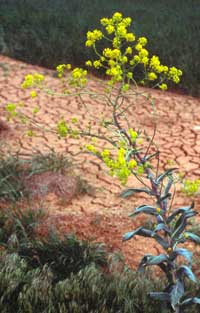Dyer’s Woad
Isatis tinctoria
Keys to Identification
- Dyers woad is a member of the mustard family. It is a winter annual, biennial or short-lived perennial, 1 to 4 feet tall. The leaves are bluish-green with a whitish vein on the upper surface. The flower has a flat top with yellow petals. The fruit is a purplish-brown pod containing one seed.
- Dyers woad has a thick tap root that can exceed 5 feet in depth. It is found in disturbed sites and spreads to range and croplands by seed from late spring to mid-summer.
This information courtesy of the Colorado Natural Areas Program
Family
Mustard (Brassicaceae)
Other Names
Woad
USDA Code
ISTI
Legal Status
Colorado Noxious Weed List A
Not common in Colorado – Notify your county weed supervisor if you discover this plant
Identification
Lifecycle
Winter annual, biennial, or short-lived perennial
Growth form
Forb
Flower
Flowers are bright yellow and clustered. Late spring.
Seeds/Fruit
Seedpods are black or purplish-brown, one-celled, with a single seed.
Leaves
There are two types of leaves, basal and stem. The basal rosette leaves are 3-4 in, oblong, lance-shaped, and connected to the stem by a petiole. The upper stem leaves are simple, alternate, bluish-green, with a whitish nerve on the upper surface of the blade. These leaves clasp the stem with ear-like projections, and decrease in size toward the top of the stem. All leaves have a slight pubescence and are nearly entire, but occasionally toothed.
Stems
Mature plants are 12-48 in tall.
Roots
It has a thick taproot that may grow 5 ft long.
Seedling
No information available.
Similar Species
Exotics
None known.
Natives
None known.
Impacts
Agricultural
Dyer’s woad reduces forage production in crop and rangelands.
Ecological
Dyer’s woad is an aggressive weed that infests disturbed and undisturbed sites and then spreads outward into crops and rangeland. The BLM projects that infestations of dyer’s woad increase 14% annually, and the Forest Service believes that it has increased several fold on Intermountain forests during the past three decades. There is some evidence that dyer’s woad produces allelopathic chemicals.
Habitat and Distribution
General requirements
Dyer’s woad appears to be well adapted to the physical and environmental conditions of the Intermountain states. It is especially well suited to dry, rocky, soils common to many steep hillsides throughout the western United States. Infestations are frequently observed in rugged inaccessible mountain terrain. Dyer’s woad is also commonly found on disturbed sites, along roadsides, waste areas and rights-of-way.
Distribution
Not yet widespread in Colorado however small populations have been sighted.
Historical
In Europe, dyer’s woad has been cultivated as a source for blue dye and for medicinal properties since the 13th century.
Biology/Ecology
Life cycle
Established dyer’s woad plants begin growth early in the year. The plant has a deep tap root as well as roots near the soil surface. Early growth plus the two-tiered root system probably account for its competitive ability. Undisturbed dyer’s woad plants behave as biennials or winter annuals and typically require portions of two growing seasons to produce seed. Dyer’s woad germinates in the fall or early spring. The seedlings develop rosettes that produce large taproots during the first year. During the winter the plants undergo vernalization. The following spring, new leaves grow from the crown bud in the rosette, and bolting begins. Flowering occurs in late spring, with the exact timing dependent upon elevation.
Mode of reproduction
Reproduces by seed.
Seed production
Hundreds of seedpods, each containing one seed, are produced anywhere from 4-6 weeks after flowering begins.
Seed bank
Seeds do not remain viable in the soil for long periods of time.
Dispersal
No information available.
References
Evans, J.O. 1991. The importance, distribution, and control of Dyer’s woad (Isatis tinctoria). Noxious Range Weeds. Edited by L.F. James, J.O. Evans, M.H. Ralphs, and R.D. Child. Westview Press, Boulder.
McConnell, E.C., J.O. Evans and S.A. Dewey. 1999. Dyer’s woad. In: R.L. Sheley and J.K. Petroff (eds.) Biology and management of noxious rangeland weeds. Oregon State University Press, Corvallis. pg. 231-237.
Whitson, T.D.(ed.), L.C. Burrill, S.A. Dewey, D.W. Cudney, B.E. Nelson, R.D. Lee, R. Parker. 1996. Dyer’s woad. Weeds of the West. Western Society of Weed Science, in cooperation with the Western United States Land Grant Universities Cooperative Extension Services, Newark CA. pg. 228.


